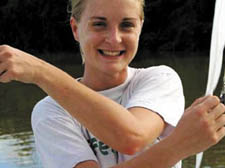|
|
 |
| |

Emily Craddock on board the Arctic Sunrise |
Documents cast doubt on Green activist’s ‘suicide’
South American authorities accused of ‘drumming up’ theory
IN the days before her tragic and untimely death Emily Craddock kept a private journal, scribbling down her thoughts about life on a Greenpeace protest vessel as it charged through the rainforest waters of Brazil.
When she fell overboard from the Arctic Sunrise boat and drowned in December 2003, senior police officers in the Amazon port of Belem said the diary contained evidence suggesting she had committed suicide.
Emily, 27, a former teaching assistant from Egbert Street, Primrose Hill, had been depressed after being “jilted” by a member of the crew, the Brazilian authorities boldly claimed.
To friends and relatives, it was an unrecognisable picture of a woman who relished her role as a radio technician for Greenpeace.
It also ran against Emily’s family’s wishes for details of the private diary to be made public.
Now, newly-released correspondence held by the Foreign Office has cast new doubt over the claims made by the Brazilian police, first to a small coroner’s court style hearing in Belem and later to reporters from the Mail on Sunday newspaper.
A chain of emails handed to the New Journal show that diplomats in South America feared that the suicide theory had been drummed up in a bid to avoid negative publicity over the issues that Emily was fearlessly campaigning over.
Her death had focussed the world’s media on the illegal destruction of the rainforest around the Xingu River and just days before she disappeared from the ship, the Greenpeace crew had clashed with wood loggers.
Names in the correspondence released to the New Journal have been crossed out for confidentiality reasons but they show that one diplomat contacted the Foreign Office with his concerns.
In a private bulletin, one ambassador said: “The chief of the federal police in Belem had told a member of the press that he had been handed a diary or diaries presumably belonging to Emily that her death might have been suicide. (It was) thought that the police may have put out this information into the public domain to dampen speculation that her death might have been the result of foul play.”
Emily’s body took three days to find in the river waters, eventually identified by dental records. By that time, speculation was rife about what might have happened to her. A reply from the Foreign Office flagged up potential help from ministers in the Cabinet and offered “any political pressure that would assist”.
Emily, a former pupil at Quintin Kynaston school in Swiss Cottage and a one-time footballer with Spurs Ladies, kept an online blog explaining Greenpeace’s crusade but she reserved her private thoughts for her diary.
The Foreign Office documents show that the family made a definitive request that her journal entries should not be discussed in public.
But Brazilian police appeared happy to discuss them with reporters.
One senior officer, Jose Sales, told an unplanned and impromptu press conference: “This ship was a refuge for people who use their liberal activism and alcohol to hide their personal problems. She joined Greenpeace for adventure and because she loved nature but, like many young idealists, she was looking for something to give her purpose.”
The Foreign Office has refused to disclose documents describing the conditions on board of the Arctic Sunrise.
Malcolm Craddock, Emily’s father, said this week that he did not want to talk about the behaviour of the Brazilian authorities.
His assistant said: “He doesn’t really want to comment beyond saying that he loathes everything one can think of about The Mail on Sunday, and this was his feeling long before Emily’s death.”
Dr Jenny Cohen, Emily’s mother, said: “She was passionate about Greenpeace, so happy to be a part of this organisation.”
An inquest in Brazil recorded an open verdict and a hearing held at St Pancras Coroner’s Court reached a similar conclusion. |
 |
|
| |
|
 |
|